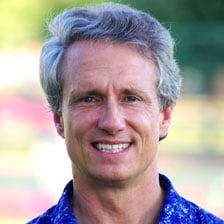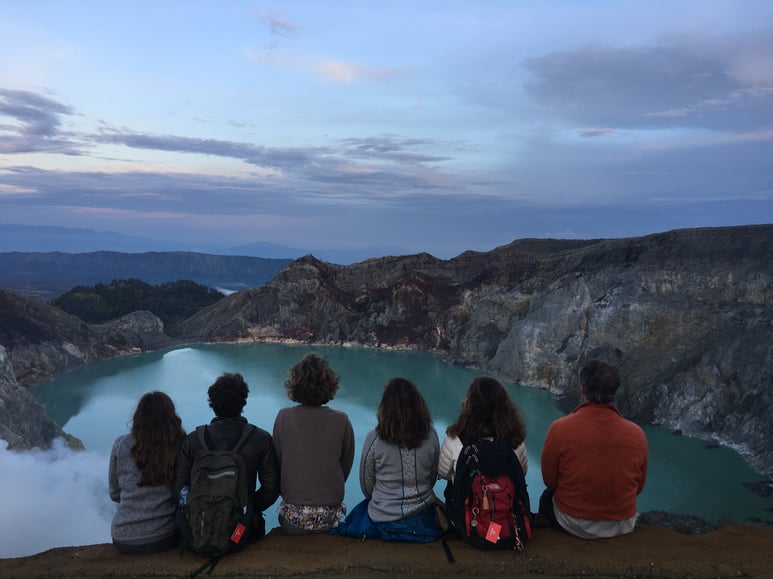
Yesterday’s volcano was a great appetizer. Today, we enjoyed the main course.
Before you get your hopes up, we still did not view lava. If you were among those that felt gypped when you had to read 3 pages to find out that, this is your chance to get out quick.
For the rest of you, I can tell you that we saw something almost as cool (or, more accurately, hot) as lava.
We saw the Blue Flame. I attempted to edit the video to 14 seconds, but managed to fail. I would suggest going to 1:00 on the video for the best shots.
According to our guide, there are only two places in the world where blue flame happens naturally, in South Africa and in the Iyju crater in Java. We would be investigating the latter.
Blue flame happens when incredibly hot sulfur gas becomes pressurize enough to become liquid. Still incredibly hot, the liquid sulfur ignites, burns a blue flame and literally flows downhill.
It is eerie and beautiful. Unlike anything I have seen in person, it felt like something James Cameron might have envisioned for the Avatar sequel. The flame burns blue because that is what burning sulfur does. If you have ever seen a firework explode into a chrysanthemum of blue, you have seen sulfur at work.
If at this point you are feeling a little jealous that we saw this exotic site, please allow me to provide the additional details that will make you perfectly happy to simply look at the photos and watch the video.
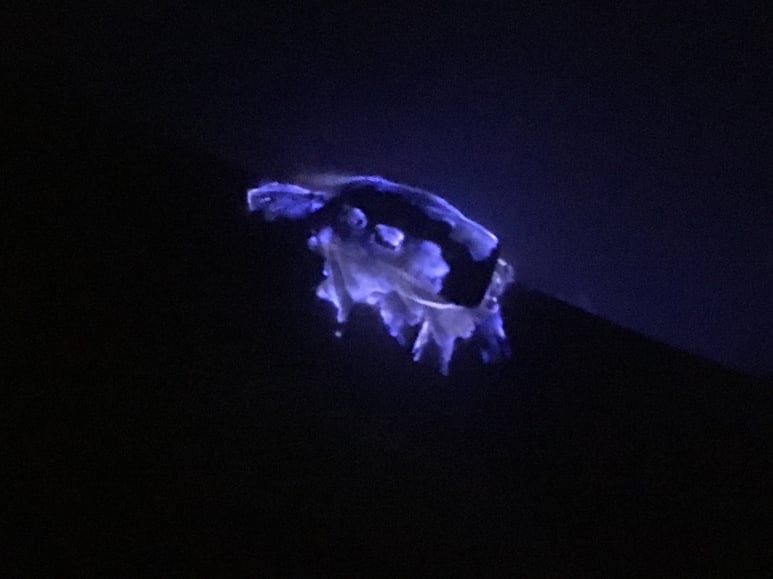
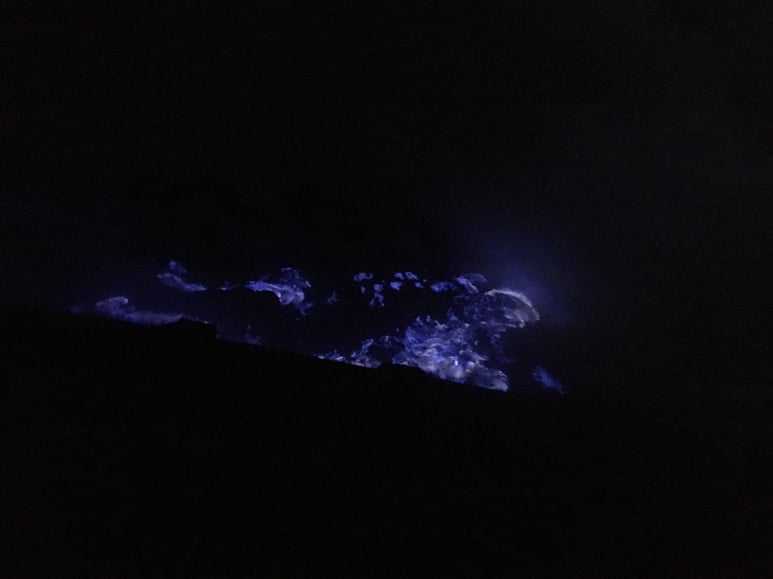
This one (with the tongue of red flame) is my favorite.
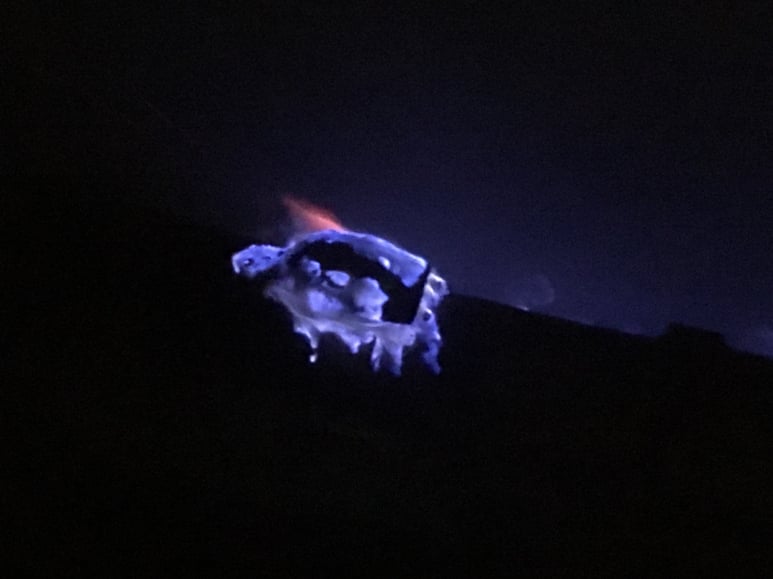
Frankly, I am not quite sure were to start. Rather than provide a detailed, blow-by-blow description of our travails, I will share the challenging aspects in bullet form:
- The blue flame must be seen at night. The sun rises at 5:10. It gets light enough to walk without a flashlight by 4:35. As a result, we needed an early start. Remember how we complained about our 3:30 start yesterday? Amateur hour. Today found us loading ourselves into our van at 12:30. {Note: as a college student, “12:30” was a frequent part of my life. I often studied later than that. I certainly enjoyed events that went far later. But I am now older and married to a woman who deeply believes in sleep. To us, “12:30 AM” is more a concept than a reality.] Ah, but we are not staying up until 12:30. We are starting a 7 hour activity then. I know I have never done that. Btw, the kids were not exactly elated the first time we dropped this factoid on them.
- Following a 30 minute drive, we started a 1.6 mile hike. The first 1.2 miles was uphill, with the grade often over 20-25 degrees for huge segments at once. On the way back out, we could fully appreciate the steepness. This helped assuage Susie’s ego. She had wondered why she had become so winded during stretches of our climb. She later realized it was because it was incredibly demanding. She was even happier once we pointed out that we passed multiple groups, but none passed us.
- The final segment to the flames was downhill into the volcano cone. Actually, “downhill” understates the challenge. The descent into the volcano was very steep with loose, slippery rocks. Each of us slipped at least twice.
- Our ascent and descent were in pitch-black darkness. We used flashlights (“torchlighters”) to find our footholds. Walking in darkness provides no perspective, so it is completely different from daytime walking. It is not unpleasant, but it does energize all your senses.
- Other climbers who would suddenly point a flashlight into our eyes. Nothing adds excitement quite like momentary blindness.
- Did I mentioned we were wearing gas masks? I am not talking about the surgical masks that you seen people in Beijing wearing to minimize inhaling pollutants. These were real gas masks. As Nizer put it, “You know, like Russia!” [Note: I wonder if Nizer has had some Russian experiences that differ from my own.]
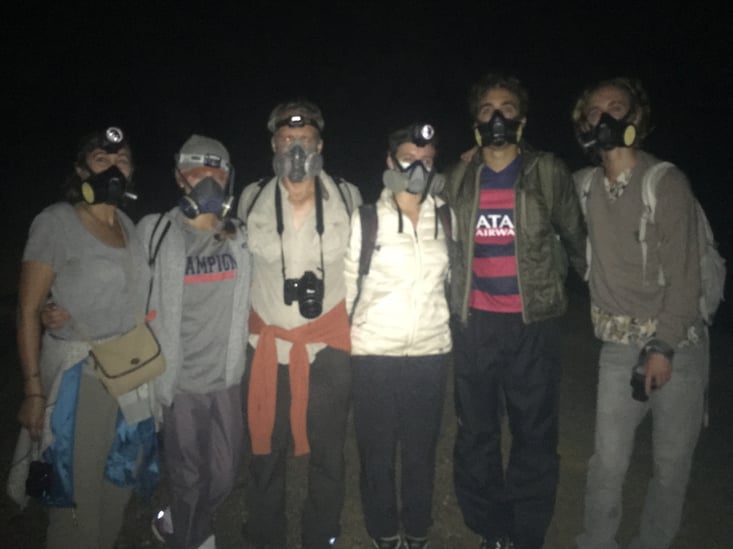
- We wore the masks because we would come within 10 feet of violent plumes of gas. At higher elevations, a wayward breeze would blow the clouds into us. For about 100 feet of our steep descent, our eyes watered heavily from the sulfur in them. The group behind us actually bailed on the experience and went back up when they encountered the cloud.
- Virginia has a period of near panic herself when we found ourselves inundated in sulfur for a second time. She manages to gather herself as Nizer spirited us to better air (oddly enough, by taking us lower – below the smoke).
- When at the site of the blue flame, another tourist kept insisting on pointing her flashlight toward the flame while another kept taking flash photos. Remember the entire point of making this an all-night journey was to see the elusive, ethereal blue flame in complete darkness. Pointing a light into the flame is like appreciating a moment of silence by violently screaming “I LOVE THIS SILENCE!”
- The crater emits carbon monoxide. Every day, the government monitors the levels before allowing people to enter the volcano. Last April, it was closed more days than it was open. While this did not directly affect us, there was the mild awareness that “the gas that you do not smell could be the one to take you out”.
- Groups of men who wanted to take selfies with Terrill and Virginia. Nizer explained that they would later tell people that T and V were their girlfriends. Creepy.
The following photo is noteworthy for two reasons. First, it shows the sulfur that forms at the points were the gas rises. Second, it was taken at 5:20 AM. Yep. The sun rises early in Bali.
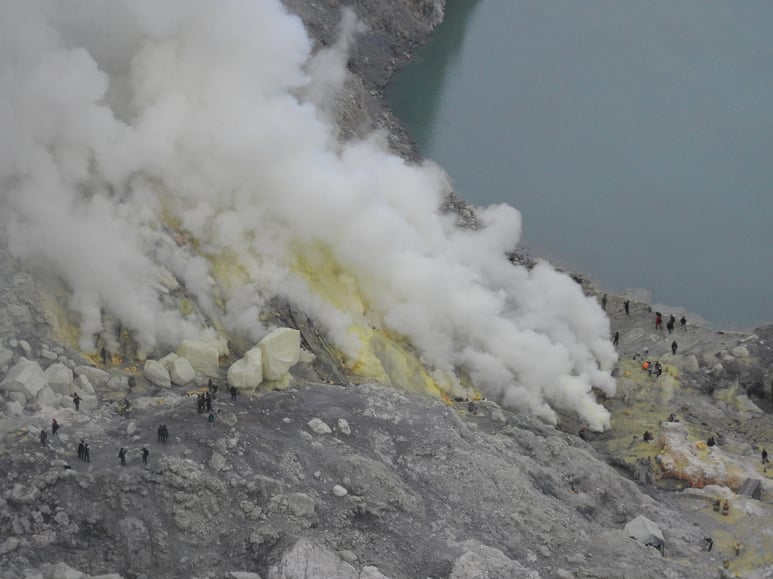
There is one additional challenge that I want to address separately. We tourists and our guides were not the only people in the volcano. We shared it with sulfur miners, a group of the toughest men I have ever seen. They are diminutive – standing 5’2”-5’4” and weighing 120-130 pounds – and often closer to my age than the kids. Allow me to describe the job of the Javanese sulfur miner (back to the bullet points):
- You begin at 1AM.
- You push a cart up the 1.2 mile, highly steep incline to the edge of the volcano.
- You then descend into the volcano and harvest some sulfur. To do so, you get right next to the smoke and blue flame and chip off 9-18 inch segments of sulfur. This is the same sulfur that had recently (within the last few days) been the source of the blue flame. It was now cool and bright yellow, but you are inhaling the smoke regularly. We were wearing masks. Despite being much closer to the poison air, they were not.
- Some miners would spoon out the cooling, but still liquid sulfur to put into molds for souvenirs. The temperature must have been extreme, like spooning out coals from a fresh fire.
- Once you mine 70 kilos of sulfur (145 pounds), you put them into two wicker baskets connected by a thick shaft of bamboo, and then walk them out. You heard me correctly, they would ascend the slippery, steep stones for a third of a mile with an awkward load – while dodging tourists. Terrill thought of it this way: “People Daddy’s age with Terrill’s weight carrying Liam up 50 stories.” Wiley suggested it was like the type of joke a cruel fraternity pledge master might conjure, “Hey pledge, carry me up that building!!”
- You do this twice a day.
- Your reward is $7.50 per load, or a total of $15.
I tried my hand at carrying one of these baskets. I did not walk with it at all. I just had it rest and balance on my shoulder for 10-15 seconds. I think of myself as fit, but I cannot imagine doing what these wiry men were doing daily.
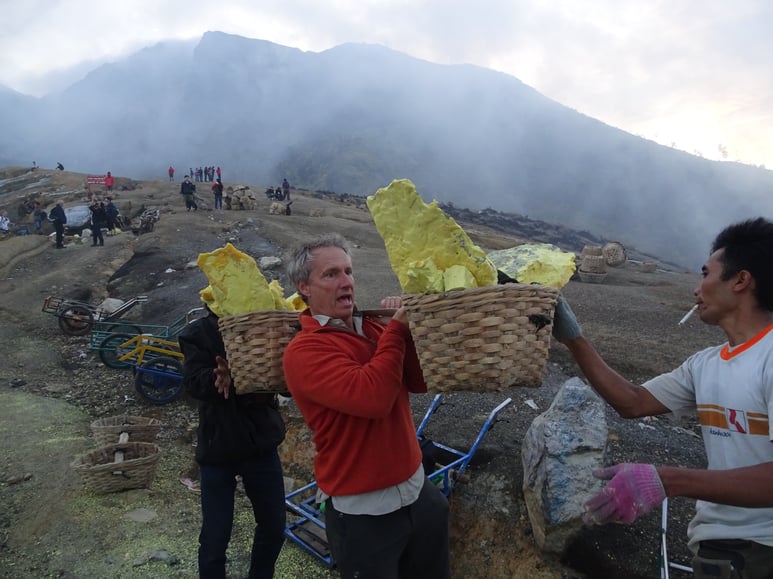
I know there are times we get frustrated in the US. Perhaps we dislike a co-worker or a boss. Maybe some government policies are angering or frustrating us. Maybe we bemoan the results of a sporting event or an election.
But, my dear friends, we are not mining sulfur. We live in a country with substantial opportunities. Certainly there are problems that understandably affect us.
So the next time you encounter a moment of aggravation or frustration, remember the sulfur miner and choose to embrace gratitude.
I plan to and am encouraging the family to as well. I suspect it will help us all . . .
. . . as long as we do not have another 12:30 wakeup call.
Steve Sir

